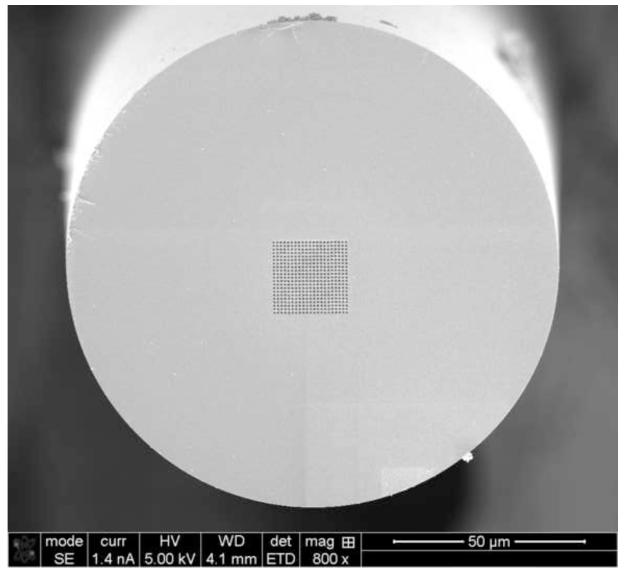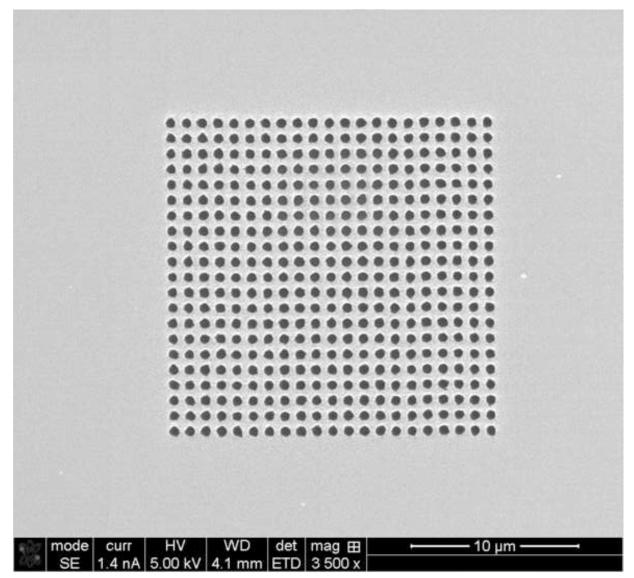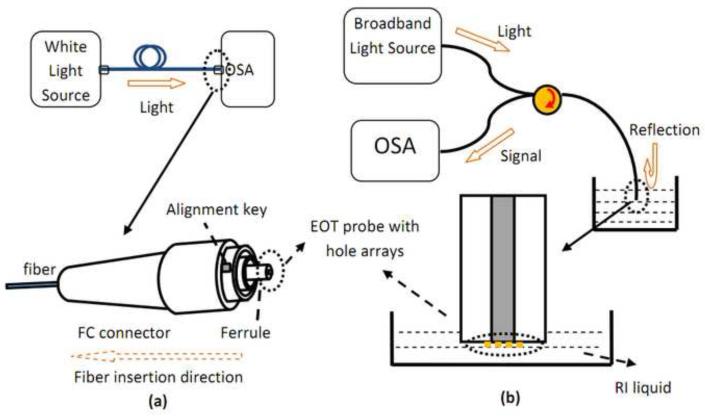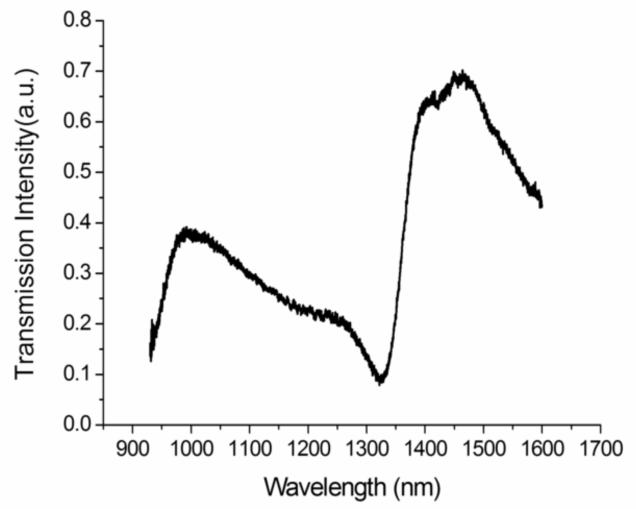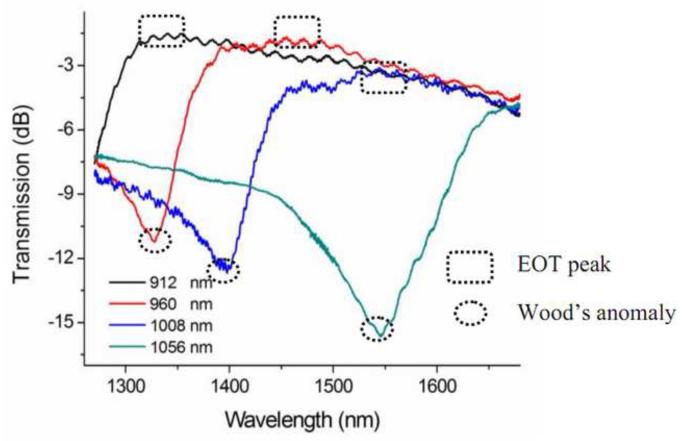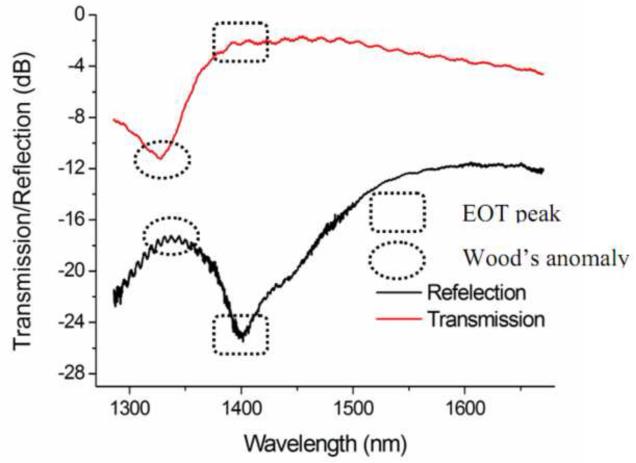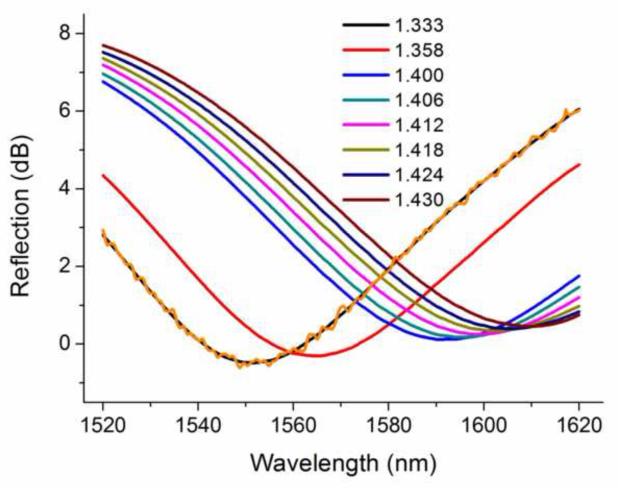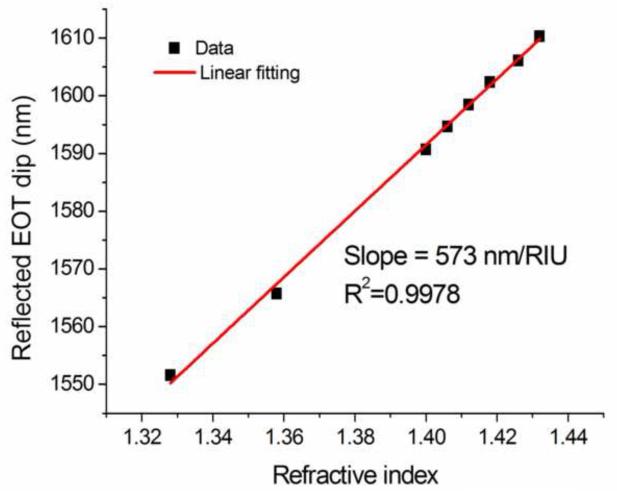Abstract
Fiber optic probes for chemical sensing based on the extraordinary optical transmission (EOT) phenomenon are designed and fabricated by perforating subwavelength hole arrays on the gold film coated optical fiber endface. The device exhibits a red shift in response to the surrounding refractive index increases with high sensitivity, enabling a reflection-based refractive index sensor with a compact and simple configuration. By choosing the period of hole arrays, the sensor can be designed to operate in the near infrared telecommunication wavelength range, where the abundant source and detectors are available for easy instrumentation. The new sensor probe is demonstrated for refractive index measurement using refractive index matching fluids. The sensitivity reaches 573 nm/RIU in the 1.333~1.430 refractive index range.
Keywords: extraordinary optical transmission, optical fiber sensor, surface plasmon resonance, refractive index sensor
1. Introduction
The optical transmission through thin metal surface perforated with subwavelength holes is a rather interesting topic, and has received much attention since the extraordinary optical transmission (EOT) was first observed in 1998 [1]. In such systems, the zero-order transmission can be larger than unity when normalized to the areas of the holes. Many experimental and theoretical works have been initiated and devoted to understanding the physics of this effect. It is generally believed that the surface plasmon polariton (SPP) modes originating from coupling of light to collective oscillation of electrons play a key role [2-4]. Later on, the Bloch-mode theory was developed to describe the enhanced evanescent field at the hole apertures and the transmitted light funneling through the hole arrays macroscopically; a comprehensive model involving the SPP mode and an additional field with a quasi-cylindrical wave was built to explain the physical origin of the Block mode microscopically [5-11]. Develop In spite of the complexity of the mechanism behind the EOT phenomenon, the structure-enhanced transmission has a wide range of potential applications, e.g., in subwavelength optics [12, 13], optoelectronic devices [14, 15], and chemical sensing [16-18].
The specific dependence of EOT resonance wavelength on the refractive index (RI) of the surrounding environment suggests the subwavelength arrays are good platform for chemical sensing. As the surrounding RI varies, the effective index at the metal interface will change to produce a wavelength shift that can be monitored for RI measurement [17]. As such, an EOT structure device can work as a label free chemical sensor. For example, a gold thin film EOT device has been demonstrated for chem/bio molecules detection with high selectivity by monitoring the real time molecular binding/interaction monitoring [16, 18]. Compared with the well-established surface plasmone resonance (SPR) analytical method, the EOT structure provides a number of advantages. For instance, the EOT structure has a small footprint (on the order of micrometers). Consequently, the signal can be generated by a smaller number of molecules and the device has better spatial resolution. Another advantage is easy optical alignment for device implementation. The combination of these features makes the EOT structure a good candidate for the development of compact chemical/biological sensors and parallel diagnostic arrays integrated with lab-on-chip devices [18].
The EOT structure can also be integrated with fiber optics to form an optical fiber probe by fabricating the perforated subwavelength metal holes directly on the endface of an optical fiber. Compared with the extensively studied fiber optic SPR sensors in which a section of the fiber core is partially exposed by polishing or etching, the EOT fiber sensor has better spatial resolution and robustness. As a fact, subwavelength nanoholes arrays have been fabricated on metal film coated optical fiber endface using focused ion beam (FIB) milling to demonstrate the EOT enhanced transmission [19]. An EOT based multimode optical fiber device has also been investigated with transmission configuration for refractive index sensing using a light source in the visible range [20]. However, all the reported devices operate in transmission mode, where the optical source and detector are separated at the two ends, making it difficult for in situ monitoring applications.
In this paper, we report a reflection based EOT fiber optic probe by FIB milling subwavelength hole arrays on a gold thin film coated fiber endface. The transmission and reflection spectra of the fabricated probes are investigated. The probes are also studied for in situ measurement of refractive index (RI) variations. Compared to a transmission-based sensor, a reflection-based probe has the advantage of easy installation during applications. A reflection-based probe can access the test environment through a single point of insertion while a transmission-based probe needs to have two access ports, one for input and the other for output. By choosing the period of the hole arrays, the sensor can be designed to operate in near infrared telecommunication band where abundant opto-electronic components (e.g., optical fiber and semiconductor based optical sources, power detectors, etc) are available for easy instrumentation.
2. Experiments
The fiber optic EOT probes were fabricated by patterning of periodic subwavelength hole arrays on gold thin film coated optical fiber endfaces using FIB milling technique. The single mode fiber employed in this paper is Corning SMF 28e with a core diameter of 8.2 μm and a cladding diameter of 125 μm. A sputtering system (Denton DESK V) was used to coat a gold thin film with a thickness of about 150 nm on the cleaved optical fiber endface.
A Helios FIB milling machine (Nano Lab 600) with a gallium ion source was used to fabricate the periodic subwavelength EOT structure. The hole-perforating area was 20 μm × 20 μm covering the core region of the optical fiber. Computer generated patterns were imported into the FIBs milling machine to fabricate the hole arrays. The periods of the hole arrays ranged from 912 to 1056 nm and the size of the holes varied from 522 to 605 nm. During hole milling, we found that the vibration and bending of the fiber tip could cause deviations of the parameters from the preset values. The fabrication precision could be further improved by more stable installation of the fiber onto the FIBs milling machine. Fig.1 shows the scanning electron microscope (SEM) images of the hole arrays with the periodicity of 960 nm and hole diameter of 550 nm, which was used in the later RI measurements. Fig. 1 (a) shows the whole fiber probe with the EOT pattern and Fig. 1 (b) depicts the zoom-in image of the hole arrays on the fiber endface. As shown in Fig. 1, the EOT pattern covered the entire region of the fiber core.
Fig. 1.
SEM images of the EOT fiber optic probe. (a) Overview of the EOT structure on the fiber endface; (b) Zoom-in image of the EOT hole arrays.
Fig. 2 (a) and (b) illustrate the setup for characterizations of transmission and reflection spectra of the fabricated EOT fiber probe, respectively. The EOT probe was excited using an unpolarized broadband light source. To obtain the desired information, light sources of different bandwidths were used to excite the plasmon in the experiments. A quartz halogen white light source (WLS100-X) with the power of 100 W and spectrum range of 350-2500 nm was used to study the EOT transmission spectrum in a wide spectrum range. A super luminescent diode (SLD) source (Agilent 83437A) with the power of ~500 nW/nm and spectrum range of 1250~1650 nm was used to study the Wood’s anomaly. An Erbium doped fiber amplified spontaneous emission (ASE) source of with the power of ~0.1 mW/nm and wavelength range of 1520~1620 nm was used to acquire the EOT reflection spectrum and test the device for RI measurement in the reflection configuration for a high signal-to-noise ratio.
Fig. 2.
Configurations for measurements of optical spectra from EOT fiber optic probe. (a) Transmission spectra measurement; (b) Reflection spectra measurement.
As shown in Fig.2 (a), during transmission spectrum measurement, the bare fiber with fabricated probe was backwards inserted into an optical fiber FC-type connector so that the fabricated probe did not touch the connector during insertion process. The transmission spectrum was directly collected by an optical spectrum analyzer (OSA, Yokogawa 6370C). To acquire the reflection spectrum, a single mode fiber circulator (Thorlabs 6015-3) was employed. Before the measurements, the loss spectrum of the circulator was measured and calibrated in the extended wavelength range of the optical source used. As shown in Fig. 2 (b), the broadband light source, fiber probe and OSA were connected to the Port 1, 2 and 3 of the fiber circulator, respectively. Reference spectra were collected to normalize the transmission and reflection signals. For the transmission configuration, the reference spectrum was directly taken using a fiber patchcord. For the reflection configuration, the reflection spectrum from a freshly cleaved singlemode fiber at Port 2 was captured as the reference.
3. Results and discussions
The transmission spectrum from the fiber EOT structure with an array period of 960 nm and hole diameter of 550 nm is shown in Fig. 3. The spectrum consists of two transmission peaks as a result of the EOT structure. The transmission valley corresponds to the Wood’s anomaly [2] in the observation wavelength range. Note that the two wavelengths at maxima points are much larger than the hole size, where the photons cannot pass through the holes freely, identified as the extraordinary transmission. In addition, the peak transmission efficiency for the second peak is about 70%, the enhanced transmission factor at that peak wavelength is about 2.66 considering the hole arrays and whole pattern areas.
Fig. 3.
Measured transmission spectrum from an EOT fiber structure using a quartz halogen white light source.
The EOT transmission spectrum is a function of the period of the hole arrays. As such, the wavelength at which the enhanced transmission occurs can be tuned by adjusting the period of the array. In general, the larger the array period is, the longer the wavelengths of the maximum and minimum are in EOT transmission spectrum. Fig. 4 plots the transmission spectra of four EOT devices with their hole array periods of 912, 960, 1008, and 1056 nm, respectively. The increasing array period caused a shift towards the long wavelength region of the transmission EOT spectrum. The observed Wood’s anomaly valleys also shifted to longer wavelengths. The tunability of EOT transmission spectrum can be very useful in sensor development. By adjusting the period of the array, the EOT transmission peak can be positioned in the 1.5 μm telecommunication window where high power light sources are abundant to obtain high-quality EOT signals.
Fig. 4.
Measured transmission spectra from EOT fiber structures with different period values using a SLD light source with 400 nm bandwidth.
Using the SLD light source, the reflection spectra from the EOT fiber structures were also measured. Fig. 5 depicts the transmission and reflection spectra from the EOT fiber probe with the array period of 960 nm and hole diameter of 550 nm. The intensity of reflection spectrum shown in Fig. 5 was subtracted by 8 dB to separate these two spectra apart for better visualization. In general, the transmission and reflection spectra have shown a good correspondence. There is a transmission minimum in the transmission spectrum at the wavelength where the Wood’s anomaly shows in the reflection spectrum. The EOT peak in the transmission spectrum also corresponds to a valley in the reflection spectrum at approximately the same wavelength.
Fig. 5.
Comparison of transmission and reflection spectra of an EOT fiber structure using a SLD light source (400 nm bandwidth). Note: the reflection spectrum was moved down by 8 dB along y axis for better visualization.
However, the full width at half maximum (FWHM) of these corresponding peaks and valleys have noticeable differences, especially in the case of the EOT peak. The EOT transmission peak is much wider than its corresponding valley in the reflection spectrum. The FWHM differences might be caused by the imperfection of the hole pattern (e.g. diameter, shape, and pitch). The incident light propagating along the fiber excites the surface palsmons (SPs) on the gold film with nanoholes at the EOT wavelength. As a result of energy coupling, a resonance dip is shown in the reflection spectrum. In the transmission mode, the generated SPs penetrate through the nanoholes and reemit on the other side of the metal film, resulting in the transmission peak at the EOT wavelength. In this translation process, the scattering of light, together with the imperfection of the hole pattern, may broaden the FWHM of the transmission spectrum. It is also observed that there were spectrum ripples in both transmission and reflection spectra, which might also be attributed to the imperfection of the hole pattern as well as the non-uniform thickness of the gold coating.
The fabricated EOT fiber probe (with the period of 960 nm) was used to characterize RI variation using commercially available RI matching liquids (Cargille Company). The values of the RI matching liquids are taken from the datasheets, which are measured at the wavelength of 589.3 nm and the temperature of 25°C. To obtain better signal strength, the light source used in this experiment was the ASE broadband source with a wavelength range of 1520~1620 nm and an output power density of −10 dBm/nm. The sensing spectrum was acquired after dipping the fiber probe into a small amount of RI liquid using the experiment setup shown in Fig. 2 (b). Deionized (D.I.) water and ethanol (Sigma-Aldrich, ≤99.5%) have also been used to test the fiber probe for comparison and referencing. Ethanol was also used as a solvent to dissolve the residual RI liquid on the fiber tip from each test. After each immersion into the RI liquid, the fiber probe was fully rinsed in ethanol. Removal of the residual RI liquid was assured by obtaining the same reference spectrum in ethanol.
Fig. 6 shows the reflection spectra of the fiber EOT probe in different RI liquids, DI water and ethanol. A third-order Savitzky-Golay filter was applied to the original spectra so that the random high frequency intensity noise and spectral ripples were removed. This smoothing filter did not alter the location of the valley, which can be verified by the comparison of original and filtered spectra in water as shown in Figure 6. As the ambient RI increases, the reflection spectrum shifted towards longer wavelengths. Like most label-free optical fiber chemical sensors, the sensitivity can be defined as the amount of wavelength shift as a function of the chemical variation induced RI change, with a unit of nano meter per refractive index units (nm/RIU). Fig. 7 plots the valley wavelength of the reflection EOT dip as a function of the ambient RI, where the wavelength shift shows a quite linear relation with the RI variations. The linear fitting of the experimental data indicated a sensitivity of ~573 nm/RIU in the RI range of 1.333~1.430. Although the FWHM of fiber EOT probe is broad, the sensitivity is comparable with other optical fiber based RI sensors, such as standard fiber gratings, fiber interferometers and non tapered fiber SPR sensors[21, 22]. The fiber EOT probe has a much smaller sensing area compared with other fiber sensors. The small size, high sensitivity, reflection mode of operation and the linear relation between the EOT wavelength and RI make the EOT fiber sensor quite useful in many practical applications. The reflection mode makes the sensor installation quite easy for in situ monitoring. The linear relation can significantly simplify the calibration process. Although the measurement of refractive index change is not molecule specific, the EOT fiber probe can be made selective to particular biological/chemical species by appropriate surface chemistry modifications, for example by coating an antibody on the surface of the EOT structure.
Fig. 6.
Reflection spectra from EOT fiber probe in DI-water, ethanol and RI liquids (the original signal in water is added for comparison with the filtered spectrum).
Fig. 7.
Center wavelengths of the reflection EOT dips as a function of surrounding RIs.
4. Conclusions
In conclusion, we reported a reflection mode fiber optic probe based on extraordinary optical transmission for refractive index sensing. The EOT structure was implemented by FIBs fabrication of a gold hole array on the tip of a standard single mode fiber. The transmission and reflection spectra of the fiber optic EOT probe have been characterized. By adjusting the array period, the EOT spectrum could be tuned to the near-IR wavelength range, where high power optical broadband sources are readily available for sensor interrogation and instrumentation. The fabricated EOT fiber probes have been demonstrated for in situ monitoring of ambient refractive index changes using DI-water, ethanol and RI matching liquids. The wavelength shift of the EOT spectrum showed a linear response to the ambient refractive index change with a sensitivity of about 573 nm/RIU in the 1.333~1.430 RI range. The small size, reflection mode operation, high sensitivity, and linear response make the EOT fiber optic probe useful for chemical/biological sensing.
Acknowledgement
This material is based upon work supported by NIH (Grant No. R21GM104696).
BIOGRAPHIES
Xinwei Lan received his Ph.D. degree in electrical engineering from Missouri University of Science and Technology in 2013. He is currently a research associate at the Center for Optical Materials Science and Engineering Technologies (COMSET), Clemson University. His research efforts has been dedicated to developing novel optical and microwave sensors for harsh environment sensing, chemical/biological sensing and structure health monitoring. Dr. Lan is a member of the Optical Society (OSA), the Institute of Electrical and Electronics Engineers (IEEE), the American Chemical Society (ACS), and the International Society for Optical Engineers (SPIE).
Baokai Cheng received his Bachelor’s and Master’s Degree in Tsinghua University in 2002 and 2006, respectively. He is now a PhD candidate in the Center for Optical Materials Science and Engineering Technologies (COMSET) of Clemson University. His major research interests focus on development of optical fiber and coaxial cable based sensors for sensing applications.
Qingbo Yang received his BS degree in Department of Bio-Engineering at Zhengzhou University in China, and received his MS in molecular biology and biochemistry from Shanghai University in China. He joined Dr. Yinfa Ma’s group since September, 2010 and currently is a Ph.D. candidate in Analytical Chemistry at Missouri University of Science and Technology. His research interests include nanomaterial safety and cytotoxicity, single cell and single molecule level imaging and analysis, enhanced Raman spectroscopy, soft tissue wound-healing effect of bioactive glass nanofibers.
Jie Huang received the B.S. degree in opto-electronic engineering from Tianjin University, Tianjin, China, in 2009 and the M.S. degree in electrical engineering in Missouri University of Science and Technology, Rolla, US, in 2012. He is currently pursuing the Ph.D. degree in electrical engineering at Clemson University. His research interest mainly focuses on the development of photonics and microwave sensors and instrumentations for applications in energy, intelligent infrastructure and biomedical sensing. Mr. Huang was a recipient of the IEEE instrumentation & measurement society graduate fellowship award from 2012 to 2013. He is a member of omicron delta kappa national leadership honor society, student members of OSA and SPIE, and a member of IEEE-Instrumentation and Measurement Society (IMS).
Hanzheng Wang is a PhD candidate in Electrical Engineering Department at Clemson University. He received his MS in Electrical Engineering in University of Missouri-Rolla in 2009. His research projects include fiber optics and optical microresonator-based chemical, temperature sensors. He is working as a graduate research assistant in Clemson University. He has two patents and more than ten journal publications. He was awarded Newport Spectra-Physics Research Excellence Awards in 2012. He is a member of SPIE, OSA, IEEE and ISA.
Yinfa Ma received his Ph.D. in analytical chemistry and minor Ph.D. in biochemistry from Iowa State University. He is a Curators’ Teaching Professor in Department of Chemistry at Missouri University of Science and Technology. His research focuses on bio-analysis and bio-separations, environmental monitoring, and single molecule and single cell imaging, by using variety of state-of-art instruments, such as high performance liquid chromatography (HPLC), high performance capillary electrophoresis (HPCE), GC-MS, HPLC-MS, HPCE-MS, gel electrophoresis, size-exclusion chromatography, and home-built single molecule and single cell imaging system.
Honglan Shi received her Ph.D. in Analytical Chemistry from Missouri University of Science and Technology in May, 2010. She is an Associate Research Professor in Department of Chemistry at Missouri University of Science and Technology. Her research mainly focus on development of advanced analytical techniques and methods for bioanalytical and environmental applications including state-of-the-art instrument development and manufacturing, bioactive glass-biofluid-bioorganism interaction study by advance analytical technologies, advanced test kit developments and manufacturing, method development for rapid characterization and quantification of engineered nanomaterials, development of novel economical and green technologies for water treatment, development of trace emerging pollutants analysis and control in natural and drinking water.
Hai Xiao received his Ph.D. in Electrical Engineering from Virginia Tech in 2000. He is a Professor in the Electrical and Computer Engineering Department at Missouri University of Science and Technology (formerly University of Missouri-Rolla). His research interest include novel micro/nano photonic structures, devices and sensors; fiber optic sensors and instrumentation for applications in harsh environment; In situ characterization of nanomaterials and nanostructures using optical methods for chemical and biological sensing; optical biomedical imaging, etc.
Footnotes
Publisher's Disclaimer: This is a PDF file of an unedited manuscript that has been accepted for publication. As a service to our customers we are providing this early version of the manuscript. The manuscript will undergo copyediting, typesetting, and review of the resulting proof before it is published in its final citable form. Please note that during the production process errors may be discovered which could affect the content, and all legal disclaimers that apply to the journal pertain.
Reference
- [1].Ebbesen TW, et al. Extraordinary optical transmission through sub-wavelength hole arrays. Nature. 1998;vol. 391:667–669. [Google Scholar]
- [2].Ghaemi HF, et al. Surface plasmons enhance optical transmission through subwavelength holes. Physical Review B. 1998;vol. 58:6779–6782. [Google Scholar]
- [3].Barnes WL, et al. Surface plasmon subwavelength optics. Nature. 2003;vol. 424:824–830. doi: 10.1038/nature01937. [DOI] [PubMed] [Google Scholar]
- [4].Gao H, et al. Direct Evidence for Surface Plasmon-Mediated Enhanced Light Transmission through Metallic Nanohole Arrays. Nano Letters. 2006 Jan 09;vol. 6:2104–2108. doi: 10.1021/nl061670r. 2006. [DOI] [PubMed] [Google Scholar]
- [5].Martín-Moreno L, et al. Theory of Extraordinary Optical Transmission through Subwavelength Hole Arrays. Physical Review Letters. 2001;vol. 86:1114–1117. doi: 10.1103/PhysRevLett.86.1114. [DOI] [PubMed] [Google Scholar]
- [6].Pendry JB, et al. Mimicking Surface Plasmons with Structured Surfaces. Science. 2004 Aug 6;vol. 305:847–848. doi: 10.1126/science.1098999. 2004. [DOI] [PubMed] [Google Scholar]
- [7].Genet C, Ebbesen TW. Light in tiny holes. Nature. 2007;vol. 445:39–46. doi: 10.1038/nature05350. [DOI] [PubMed] [Google Scholar]
- [8].Liu H, Lalanne P. Microscopic theory of the extraordinary optical transmission. Nature. 2008;vol. 452:728–731. doi: 10.1038/nature06762. [DOI] [PubMed] [Google Scholar]
- [9].Liu H, Lalanne P. Comprehensive microscopic model of the extraordinary optical transmission. J. Opt. Soc. Am. A. 2010;vol. 27:2542–2550. doi: 10.1364/JOSAA.27.002542. [DOI] [PubMed] [Google Scholar]
- [10].Lalanne P, Liu H. A New Look at Grating Theories Through the Extraordinary Optical Transmission Phenomenon. In: Enoch S, Bonod N, editors. Plasmonics. vol. 167. Springer; Berlin Heidelberg: 2012. pp. 85–103. [Google Scholar]
- [11].van Beijnum F, et al. Quasi-cylindrical wave contribution in experiments on extraordinary optical transmission. Nature. 2012;vol. 492:411–414. doi: 10.1038/nature11669. [DOI] [PubMed] [Google Scholar]
- [12].Alkaisi MM, et al. Sub-diffraction-limited patterning using evanescent near-field optical lithography. Applied Physics Letters. 1999;vol. 75:3560–3562. [Google Scholar]
- [13].Xiangang L, Ishihara T. Sub 100 nm lithography based on plasmon polariton resonance. Microprocesses and Nanotechnology Conference, 2003. Digest of Papers. 2003 International.2003. pp. 138–139. [Google Scholar]
- [14].Collin S, et al. Resonant-cavity-enhanced subwavelength metal--semiconductor--metal photodetector. Applied Physics Letters. 2003;vol. 83:1521–1523. [Google Scholar]
- [15].Liu C, et al. Efficiency enhancement of an organic light-emitting diode with a cathode forming two-dimensional periodic hole array. Applied Physics Letters. 2005;vol. 86:143501–3. [Google Scholar]
- [16].Brolo AG, et al. Surface Plasmon Sensor Based on the Enhanced Light Transmission through Arrays of Nanoholes in Gold Films. Langmuir. 2004 Jan 06;vol. 20:4813–4815. doi: 10.1021/la0493621. 2004. [DOI] [PubMed] [Google Scholar]
- [17].Gordon R, et al. A New Generation of Sensors Based on Extraordinary Optical Transmission. Accounts of Chemical Research. 2008 Jan 08;vol. 41:1049–1057. doi: 10.1021/ar800074d. 2008. [DOI] [PubMed] [Google Scholar]
- [18].Chang T-Y, et al. Large-scale plasmonic microarrays for label-free high-throughput screening. Lab on a Chip. 2011;vol. 11:3596–3602. doi: 10.1039/c1lc20475k. [DOI] [PubMed] [Google Scholar]
- [19].Thio T, et al. Strongly enhanced optical transmission through subwavelength holes in metal films. Physica B: Condensed Matter. 2000;vol. 279:90–93. [Google Scholar]
- [20].Dhawan A, Muth JF. Engineering surface plasmon based fiber-optic sensors. Materials Science and Engineering: B. 2008;vol. 149:237–241. [Google Scholar]
- [21].Fan X, et al. Sensitive optical biosensors for unlabeled targets: A review. Analytica Chimica Acta. 2008;vol. 620:8–26. doi: 10.1016/j.aca.2008.05.022. [DOI] [PMC free article] [PubMed] [Google Scholar]
- [22].Díaz N, et al. Refractive index sensing of aqueous media based on plasmonic resonance in tapered optical fibres operating in the 1.5μm region. Sensors and Actuators B: Chemical. 2010;vol. 146:195–198. [Google Scholar]



